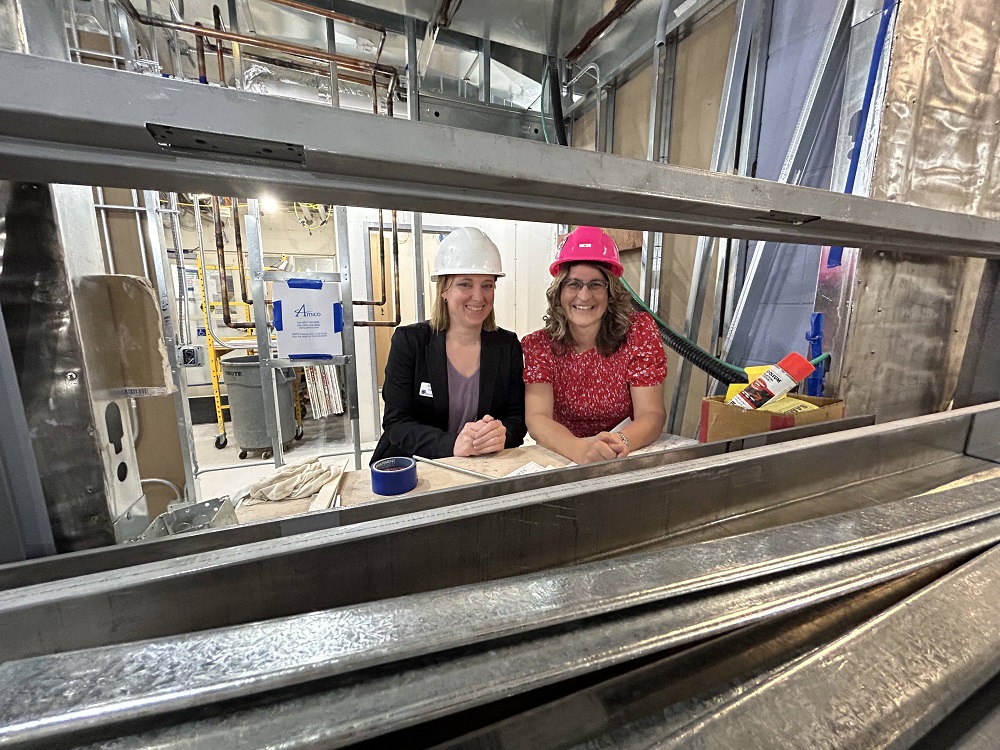Construction on a new wing housing CT-related services at Haliburton Highlands Health Services will wrap up in about six weeks, says hospital president and CEO, Veronica Nelson.
Media was invited to attend a walkthrough of the space May 17 – two and a half months after construction began. Nelson said it’s been a quick transformation, with Orillia-based Quinan Construction turning approximately 1,000 sq. ft. of storage and waiting room space into the Haliburton hospital’s new home for CT.
There will be a waiting area, changeroom, and two washrooms. The CT suite includes scan and control rooms, ultrasound room, and storage area. It will accommodate six to eight patients at a time, Nelson said.
Hannah Brown, a casual medical radiation technologist at HHHS, has been hired to run the CT unit. Nelson said Brown will start her new role June 3. It’ll be a busy month, with the Siemens Healthineers SOMATOM go.Top CT scanner to arrive June 17, and construction to wrap up by early July.
Nelson said other staff will be trained on the machines beginning July 8. The hospital will start taking bookings that week.
“It’s very exciting seeing the progress, the finishing line getting that much closer. This is the biggest, most significant enhancement this hospital has seen since it was built in 2001, and it’s all just a few weeks away from completion,” Nelson said. “This long-standing dream is finally becoming a reality.”
It’s all music to the ears of Tim Waite, the County’s EMS chief, who has been quietly advocating for a CT scanner for several years. Haliburton County is the only region in Ontario currently without the diagnostics device.
Fewer ambulances to leave County
That means Waite has had to deal with almost daily – sometimes more – patient transfers to other hospitals in Lindsay, Peterborough, Huntsville, Bracebridge, and even Kingston. This routinely takes County ambulances and EMS staff out of the community for up to six hours, he said.
In 2023, Haliburton County EMS completed more than 350 patient transfers – the bulk of those for CT scans.
“This is certainly a game-changer for EMS. CT transfers contribute to a significant amount of time where we have ambulances outside Haliburton County – none of these are scheduled, they are all for patients who arrive at the ER in Haliburton with an illness or injury that requires further diagnostics,” Waite said, noting his crew usually waits for the patient to get their scan before transporting them home.
There are four ambulances on the road during peak times, between 11 a.m. and 11 p.m., dropping to three for the overnight shift. Waite said there will be an additional ambulance serving the community on weekends through the summer.
“It’s a bit of a juggling act at times – we certainly have those days that are extremely busy, where we have two ambulances away for transfers. Sometimes all it takes is one big incident, or a car crash, and we have multiple people requiring transfer,” Waite noted.
When backed up, Waite said paramedics often have to make difficult choices prioritizing people for transfer based on the severity of their issue. He likes to ensure there are always at least two ambulances available in the County.
Freeing up ambulance crews to respond almost exclusively to local calls is important Waite said, given call volumes have increased approximately 40 per cent since 2020.
“We have seen those numbers settling down in the last year as far as the big jumps go, but they are still increasing. Where this will help is having more trucks active inside the County servicing 911 calls… we’ll be able to monitor our response time targets and meet them more easily,” Waite said.
He warned, though, there will still be occasions when ambulances need to transport patients out-of-County – if a CT scan shows something that requires more specialized treatment, or if further testing is required.
Waite said there would likely be some cost savings, for things like fuel, but he didn’t have an approximate number. In 2022, he told The Highlander the average transfer for CT costs $720. Based on the department completing 350 transfers per year, savings could reach $252,000 annually.
The total cost of CT and mammography expansion has been touted at between $3 and $3.5 million. The HHHS Foundation has committed to raising $4.3 million for the project.
Executive director Melanie Klodt Wong kicked off the fundraising campaign last week, announcing they have raised $2.59 million – just over 60 per cent of the way towards meeting its goal.
“We want to have this wrapped up sooner than any other campaign I’ve worked on before. This is really fast and furious, we want to get this all paid off as soon as possible,” Klodt Wong said. “If anyone is considering making a donation, now is the time. This is your chance to support an important, life-changing project that’s going to help, in some way, every person in this community.”
To make a donation, contact mklodtwong@hhhs.ca or 705457-1580.





